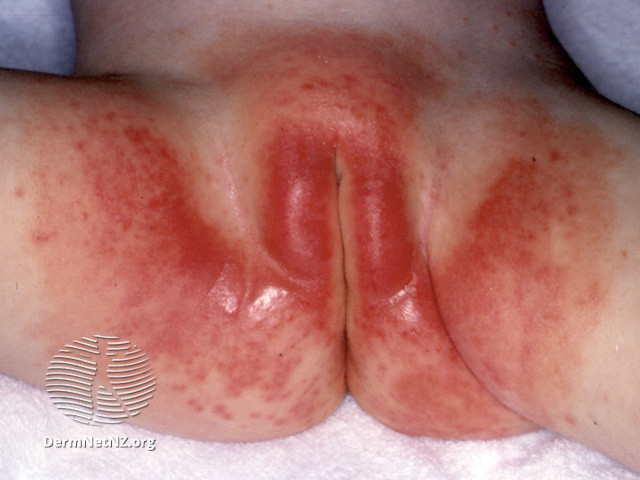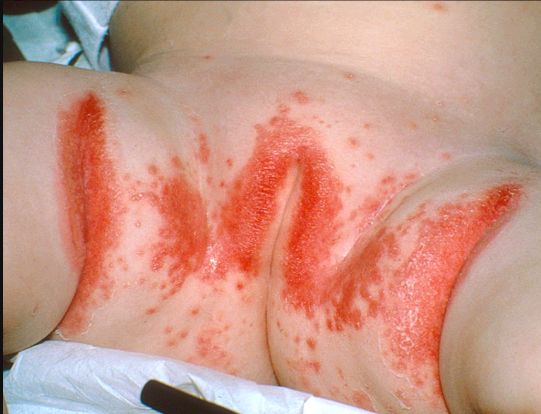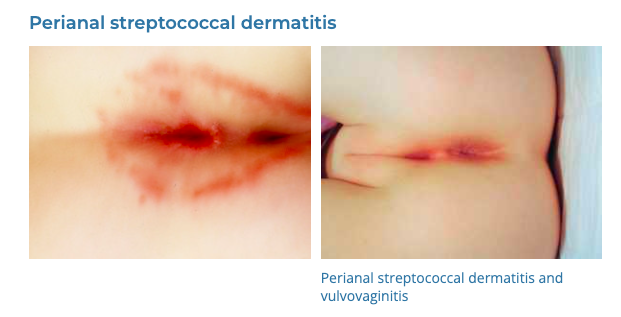- Irritant contact dermatitis nappy rash
- When skin becomes irritated by something touching it, the result is irritant contact dermatitis. This is the most common type of nappy rash. In the nappy area, the cause of irritant contact dermatitis can be:
- Urine
- Feces, especially diarrhea
- The nappy itself, and the chemicals used to make it
- Chemical-containing skin wipes that you use to clean the nappy area
- Chemicals in lotions or ointments that you use in the nappy area
- Irritant contact dermatitis nappy rash often starts out as a flat, pink rash in areas where the irritant touched the skin.
- Areas of skin that are protected — like places tucked deep inside skin folds — often stay normal and look healthy.
- The longer an irritant stays against the skin, the worse the pain and redness become.
- When skin becomes irritated by something touching it, the result is irritant contact dermatitis. This is the most common type of nappy rash. In the nappy area, the cause of irritant contact dermatitis can be:
- Allergic contact dermatitis
- Sometimes a baby can develop an allergy to a product you use on their skin. This type of rash can show up when you first use the new product, or there can be a delay for as long as several weeks. The most common causes of allergic contact dermatitis are fragrances, colorings, or other chemicals in:
- Prepackaged baby wipes
- Ointments and creams
- Detergents you use to wash cloth nappys
- Chemicals used to make disposable nappys
- Babies with allergic contact dermatitis will develop a red, often scaly rash in areas that come into contact with that allergen. The rash can extend to skin outside the nappy, including areas that didn’t even directly touch the allergen.
- Allergic contact dermatitis can start out mild, but it will become more severe if you don’t remove the allergen.
- Sometimes a baby can develop an allergy to a product you use on their skin. This type of rash can show up when you first use the new product, or there can be a delay for as long as several weeks. The most common causes of allergic contact dermatitis are fragrances, colorings, or other chemicals in:
- Candida nappy rash
- Candida albicans is a type of yeast (fungus) that lives inside the gut. It’s also in faeces.
- It causes nappy rash because the warm, humid environment inside a nappy is an ideal place for yeast to grow.
- A yeast nappy rash looks like hundreds of tiny round spots, which can range from pale pink to bright red.
- The rash tends to start in the skin folds (unlike irritant contact or allergic)
- Strep nappy rash (Perianal strep)
- Streptococcus pyogenes is a type of bacterial nappy rash that is often misdiagnosed.
- In older children S. pyogenes causes strep throat and other problems but in babies, strep can cause an intense nappy-area rash called “perianal strep.”
- Perianal strep looks like an angry, bright red patch around the anus.
- Staph nappy rash
- Occasionally Staphylococcus aureus adds to the problem of nappy rash.
- This is most likely to happen when the skin is already inflamed or damaged, because bacteria can enter the skin and cause an infection.
- S. aureus nappy rash often looks like a red pimple with a white or yellow center and if it pops, it can drain pus.
- Hand, foot, and mouth disease
- Hand, foot, and mouth disease is a contagious viral infection that is very common in young children.
- Babies and toddlers who catch HFM often get rashes on their hands, feet, face, and in their nappy area.
- The nappy rash that comes with HFM disease looks like dozens of pink or red spots.
Management
- Frequent nappy Changes: Change nappys frequently to keep the skin dry and reduce exposure to irritants. This is especially important after bowel movements.
- Gentle Cleaning: Gently clean the nappy area with warm water and a soft cloth during each nappy change. Avoid vigorous rubbing. While baby wipes can be used, choose alcohol-free and fragrance-free wipes to minimize irritation.
- Air Exposure: Allow the baby’s skin to air dry before putting on a new nappy. Some time without a nappy each day can be very beneficial.
- Barrier Creams or Ointments: Apply a thick layer of a barrier cream or ointment to protect the skin from moisture. Zinc oxide and petroleum jelly are common ingredients. Apply them at each nappy change after the skin is dry.
- Avoid Irritants: Avoid using products with potential irritants such as alcohol, fragrances, or preservatives. Choose hypoallergenic and fragrance-free soaps, lotions, and laundry detergents.
- Proper nappy Fit: Ensure that nappys are not too tight, as this can cause chafing and reduce airflow. However, they should be snug enough to prevent leaks.
- Bath Time: Limit the duration of baths and use lukewarm water. Avoid excessive use of soap. After the bath, gently pat the skin dry without rubbing.
- Laundry Care: Wash cloth nappys carefully. Use a mild detergent and rinse them thoroughly to remove all soap residue. Avoid fabric softeners and dryer sheets.
- Observation for Infection: If the rash is severe, does not improve with care, or is accompanied by fever, blisters, or pus-filled sores, consult a healthcare provider. Infections, such as those caused by Candida, Step or Staph, might require medical treatment.
- Dietary Considerations: In older infants, certain foods that are ingested can affect their stool and may contribute to nappy rash. Monitor for any correlation and discuss with a pediatrician if dietary changes are needed.
In most cases, nappy rash can be managed effectively with these measures, however, if the rash persists, worsens, or if there are signs of infection, it’s important to seek medical advice.
https://dermnetnz.org/topics/napkin-dermatitis-images
Nappy Rash sparing the creases

Candida Nappy Rash (creases of thighs)

Perianal Streptococcal dermatitis

